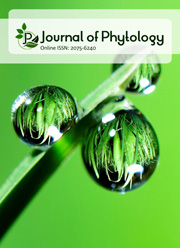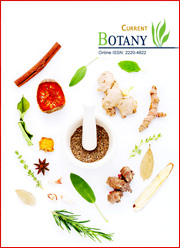Phytochemical composition and biological activities of Dorcoceras uthongensis (Gesneriaceae) - A new species from the limestone karst of Suphan Buri, Thailand
DOI:
https://doi.org/10.25081/jp.2024.v16.9037Keywords:
Dorcoceras, New species, Trichome, Biological activity, Phytochemical composition, LC-MS/MS-QTOFAbstract
Dorcoceras uthongensis, a new species of the genus Dorcoceras Bunge, is described. This new species is endemic to Uthong district, Suphan Buri province, Thailand, and differs from the other species by exhibiting capitate glandular hairs with globose unicellular head on the abaxial surface of the leaf. Additionally, it is classified as an endangered species (EN) according to IUCN criteria. The phylogenetic analysis based on nuclear ITS1-5.8S-ITS2 confirmed its placement within Dorcoceras. Moreover, we sought to explore the potential biological activities of the crude extract of this new species. We evaluated the aqueous extract of leaves which revealed antioxidant activity and no cytotoxicity indicating potential safety for further research and utilization. To examine the phytochemical composition, we performed an analysis using LC-MS/MS-QTOF. The result revealed the presence of flavonoids, alkaloids, phenolic compounds, and terpenes.
Downloads
References
Akaike, H. (1974). A new look at the statistical model identification. IEEE Transactions on Automatic Control, 19(6), 716-723. https://doi.org/10.1109/TAC.1974.1100705
Bachman, S., Moat, J., Hill, A. W., de la Torre, J., & Scott, B. (2011). Supporting Red List threat assessments with GeoCAT: geospatial conservation assessment tool. ZooKeys, 150, 117-126. https://doi.org/10.3897/zookeys.150.2109
Bauer, A. W., Kirby, W. M., Sherris, J. C., & Turck, M. (1966). Antibiotic susceptibility testing by a standardized single disk method. American Journal of Clinical Pathology, 45(4), 493-496.
Chen, P.-J., Lin, E.-S., Su, H.-H., & Huang, C.-Y. (2023). Cytotoxic, antibacterial, and antioxidant activities of the leaf extract of Sinningia bullata. Plants, 12(4), 859. https://doi.org/10.3390/plants12040859
Darriba, D., Taboada, G. L., Doallo, R., & Posada, D. (2012). jModelTest 2: more models, new heuristics and parallel computing. Nature Methods, 9, 772. https://doi.org/10.1038/nmeth.2109
Di Simone, S. C., Flores, G. A., Acquaviva, A., Nilofar, Libero, M. L., Venanzoni, R., Tirillini, B., Orlando, G., Zengin, G., Lai, F., Fiorini, D., Angelini, P., Menghini, L., & Ferrante, C. (2023). Phytochemical and biological properties of the water extract from roots and leaves of Lactuca longidentata, an endemic phytoalimurgic (food) species of Central Sardinia (Italy). Plant Biosystems - An International Journal Dealing with all Aspects of Plant Biology, 157(3), 594-604. https://doi.org/10.1080/11263504.2023.2166620
Edgar, R. C. (2004). MUSCLE: multiple sequence alignment with high accuracy and high throughput. Nucleic Acids Research, 32(5), 1792-1797. https://doi.org/10.1093/nar/gkh340
Emsen, B., Surmen, B., & Karapinar, H. S. (2023). In vitro antioxidant and cytotoxic effects of three endemic plants from Turkey based on their phenolic profile. Plant Biosystems - An International Journal Dealing with all Aspects of Plant Biology, 157(2), 346-356. https://doi.org/10.1080/11263504.2023.2165561
Ibrahim, S. R. M., & Mohamed, G. A. (2015). Litchi chinensis: medicinal uses, phytochemistry, and pharmacology. Journal of Ethnopharmacology, 174, 492-513. https://doi.org/10.1016/j.jep.2015.08.054
Kok, O., Emsen, B., & Surmen, B. (2023). Screening of in vitro cytotoxicity and antioxidant potential of selected endemic plants in Turkey. Journal of Taibah University for Science, 17(1), 2217369. https://doi.org/10.1080/16583655.2023.2217369
Kondeva-Burdina, M., Zheleva-Dimitrova, D., Nedialkov, P., Girreser, U., & Mitcheva, M. (2013). Cytoprotective and antioxidant effects of phenolic compounds from Haberlea rhodopensis Friv. (Gesneriaceae). Pharmacognosy Magazine, 9(36), 294-301. https://doi.org/10.4103/0973-1296.117822
Koyama, R., Ishibashi, M., Fukuda, I., Okino, A., Osawa, R., & Uno, Y. (2022). Pre- and post-harvest conditions affect polyphenol content in strawberry (Fragaria × ananassa). Plants, 11(17), 2220. https://doi.org/10.3390/plants11172220
Kumar, S., Stecher, G., & Tamura, K. (2016). MEGA7: molecular evolutionary genetics analysis version 7.0 for bigger datasets. Molecular Biology and Evolution, 33(7), 1870-1874. https://doi.org/10.1093/molbev/msw054
Lee, I.-G., Lee, J., Hong, S.-H., & Seo, Y.-J. (2023). Apigenin's therapeutic potential against viral infection. Frontiers in Bioscience, 28(10), 237. https://doi.org/10.31083/j.fbl2810237
Panvilai, S., Napaswad, C., Limthongkul, J., & Akkarawongsapat, R. (2020). Aqueous extracts of Thai medicinal plants possess anti-HIV-1 activity. Journal of Herbs, Spices & Medicinal Plants, 27(1), 1-10. https://doi.org/10.1080/10496475.2020.1753276
Prajanban, J., & Panvilai, S. (2021a). Dorcoceras wallichii. Collected from Mae Wa Waterfall, Lampang, Thailand, 17°26'20.1"N, 99°13'51.0"E, on 26 December 2021
Prajanban, J., & Panvilai, S. (2020). Dorcoceras uthongensis. Collected from Bansrisanpet Community Forest, Suphan Buri, Thailand, 14°22'30.4"N, 99°51'41.3"E, on 12 September 2020
Prajanban, J., & Panvilai, S. (2021b). Dorcoceras brunnuem. Collected from Wat Phrom Lok Khao Yai, Kanchanaburi, Thailand, 14°12'13.2"N, 99°08'00.8"E, on 10 December 2021
Prajanban, J., & Panvilai, S. (2021c). Dorcoceras glabrum. Collected from Khao Pat Thawi, Kanchanaburi, Thailand, 14°00'57.6"N, 99°19'24.2"E, on 10 December 2021
Prajanban, J., & Panvilai, S. (2022). Dorcoceras geoffrayi. Collected from Wat Phu Tok, Buengkan, Thailand, 18°08'07.0"N, 103°52'58.4"E, on 2 October 2022
Puglisi, C., & Middleton, D. J. (2017). A revision of Dorcoceras (Gesneriaceae) in Thailand. Thai Forest Bulletin (Botany), 45, 10-17. https://doi.org/10.20531/tfb.2017.45.1.03
Puglisi, C., Yao, T. L., Milne, R., Möller, M., & Middleton, D. J. (2016). Generic recircumscription in the Loxocarpinae (Gesneriaceae), as inferred by phylogenetic and morphological data. Taxon, 65(2), 277-292. https://doi.org/10.12705/652.5
Rambaut, A. (2022). FigTree v. 1.4. 4. 2018.
Ronquist, F., Teslenko, M., van der Mark, P., Ayres, D. L., Darling, A., Höhna, S., Larget, B., Liu, L., Suchard, M. A., & Huelsenbeck, J. P. (2012). MrBayes 3.2: efficient Bayesian phylogenetic inference and model choice across a large model space. Systematic Biology, 61(3), 539-542. https://doi.org/10.1093/sysbio/sys029
Salehi, B., Venditti, A., Sharifi-Rad, M., Kręgiel, D., Sharifi-Rad, J., Durazzo, A., Lucarini, M., Santini, A., Souto, E. B., Novellino, E., Antolak, H., Azzini, E., Setzer, W. N., & Martins, N. (2019). The therapeutic potential of apigenin. International Journal of Molecular Sciences, 20(6), 1305. https://doi.org/10.3390/ijms20061305
Schinazi, R. F., Chu, C. K., Babu, J. R., Oswald, B. J., Saalmann, V., Cannon, D. L., Eriksson, B. F. H., & Nasr, M. (1990). Anthraquinones as a new class of antiviral agents against human immunodeficiency virus. Antiviral Research, 13(5), 265-272. https://doi.org/10.1016/0166-3542(90)90071-e
Sun, Y., Liu, X., Fu, X., Xu, W., Guo, Q., & Zhang, Y. (2023). Discrepancy study of the chemical constituents of Panax ginseng from different growth environments with UPLC-MS based metabolomics strategy. Molecules, 28(7), 2928. https://doi.org/10.3390/molecules28072928
Verdan, M. H., & Stefanello, M. L. A. (2012). Secondary metabolites and biological properties of Gesneriaceae species. Chemistry & Biodiversity, 9(12), 2701-2731. https://doi.org/10.1002/cbdv.201100246
White, T. J., Bruns, T., Lee, S., & Taylor, J. (1990). Amplification and direct sequencing of fungal ribosomal RNA genes for phylogenetics. PCR Protocols, 315-322. https://doi.org/10.1016/b978-0-12-372180-8.50042-1
Yang, L.-Y., Yi, P., Chen, J.-L., Li, Y.-H., Qiu, J.-L., Wang, Z.-Y., Fu, M., Yuan, C.-M., Huang, L.-J., Hao, X.-J., & Gu, W. (2023). Chemical constituents of Primulina eburnea (Gesneriaceae) and their cytotoxic activities. Chemistry & Biodiversity, 20(5), e202300248. https://doi.org/10.1002/cbdv.202300248
Zhao, L., & Zheng, L. (2023). A review on bioactive anthraquinone and derivatives as the regulators for ROS. Molecules, 28(24), 8139. https://doi.org/10.3390/molecules28248139
Published
How to Cite
Issue
Section
Copyright (c) 2024 Jaran Prajanban, Wichai Patumchartpat, Radeekorn Akkarawongsapat, Chanita Napaswad, Sathit Panvilai

This work is licensed under a Creative Commons Attribution 4.0 International License.





 .
.